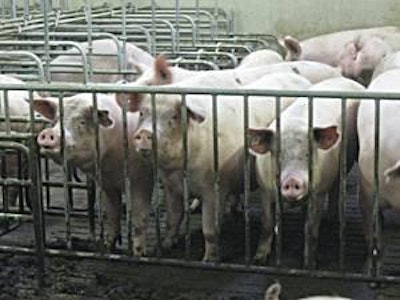
One of the main health challenges in pig group housing systems is that sow leg problems become more apparent. Sows must be able to walk smoothly to reach the feeding trough or feeding station and escape from ranking fights.
Leg weakness in group housing
According to a recent study that compared pig group and individual housing, the incidence of sow culling because of leg weakness was twice as high in group housing as in individual housing.
Culling affects the profitability of the unit—more culling results in a higher replacement gilt cost. Also, in group housed systems, new gilts need extra attention to get used to the feeding station and to introduce them into a stable group of sows.
In the Netherlands, the annual sow replacement rate is 42%, which is high. To improve the viability of its sustainability and animal welfare this replacement percentage must be reduced. This is particularly important for European Union pig producers, who are being forced to move to group housing under new animal welfare laws, which states that all gestating sows must be group housed by January 1, 2013.
The incidence of sow feet and leg problems and lameness in group housing is determined by many factors, such as the housing system, type of floor, genetics, herd management and nutrition. In addition, increased prolificacy in the past 10 years has put more pressure on a sow’s skeleton, legs and claws.
Pig productivity has nearly doubled in the past 40 years as shown in Figure 1. This means that pregnant sows are carrying more weight from more piglet fetuses and a larger uterus. This results is more pressure on the locomotion system. Post farrowing, the sow has had to cope with increased milk production to feed additional piglets. This requires greater mobilization of calcium and phosphorus from the bones during lactation. While concentrating on the role of nutritional aspects in reducing lameness, it must be remembered that this is only one piece of the puzzle.
However, nutritional measures cannot compensate for other causes of lameness like poor housing conditions or slippery flooring.
Strong skeleton
Preventing lameness starts with ensuring well-developed gilts with good, strong skeletons. Several experiments have demonstrated that increasing a gilt’s growth rates with a higher feed level results in more leg weakness and a shorter sow productive life. Hence, gilts should be reared with a gradual feeding schedule allowing for a balanced development. Because gilts have special requirements for nutrient balance, particularly calcium, phosphorus and amino acids, a specialized gilt diet should be used. The aim is to have a 140 kg gilt at 240 days of age at first insemination.
During gestation, a sow’s rations should be restricted to prevent excessive weight gain. A high body weight may lead to overloading on the joints but by controlling feed intake, there is a risk of aggressiveness and fights occurring between sows. One way to overcome aggressiveness is to have a minimum level of fermentable fibers in a sow’s gestation diets of 20%. Fermentable fibers slow down digestion and satisfy the animal’s appetite longer, which leads to quieter sows.
To achieve strong bones, sows need adequate calcium and phosphorus in the gestation diet. Research has demonstrated that moderate deficiencies of these minerals lead to a lower growth rate and productivity, but not to lameness. Only severe deficiencies of these minerals lead to lameness and simply adding extra calcium or phosphorus to the diet seldom solves the problem.
Right mineral balance
It is important that calcium and phosphorus are supplied in the right balance in a sow’s ration. Too much calcium in pig feed can lead to reduced phosphorus absorption. If calcium levels are too low, the storage of phosphorus in the bones is impaired. The optimal ratio of calcium to digestible phosphorus is around 3:1.
During gestation, the sow must be able to store sufficient calcium and phosphorus in the bones so she is well-equipped for her lactation when they are mobilized from the bones. Phytase should be added to the sow diet to facilitate this. Calcium and phosphorus is bound to phytate in vegetable components. Recent research has demonstrated that extra magnesium in the pig feed also increases calcium storage in bones.
If a sow’s diet has an overload of anions compared to cations, the risk of acidosis - low blood pH – increases. The main anions responsible for this are chlorine (Cl- ) and sulphate
(SO42-). Benzoic acid can also induce acidosis. The effect of excess anions can be compensated by increasing the cations in the diet with sodium ( Na+ ) and potassium (K+). In case of acidosis, the kidneys actively excrete (H+). This is accompanied by excretion of buffers like HPO42- that is mobilized from the bones. Calcium is also released from the bones during this mobilization.
If the incidence of acidosis is prolonged, less bone formation and even bone degradation will take place because of calcium mobilization. Therefore, care must be taken to avoid excessive levels of acidifying compounds like sulphates in the sow gestation diet. Sulphates may occur in high levels in certain byproducts from the food industry or, in some sources of DDGS, if sulphuric acid has been used in the production process.
Claw lesions
Claw lesions play a role in sow lameness. In group housing systems claws can be easily damaged. Claw lesions may also be secondary, in the case of joint or leg deformations caused by the above mentioned mineral imbalances. A deficiency of biotin (a B vitamin) also can lead to claw lesions.
Therefore, in group housing systems, 400 microgram/kg biotin in the feed is advised. Recommended levels of trace minerals like copper and zinc should also be provided in the diet to ensure healthy claws.
Looking ahead, many pig producers will be experiencing the pros and cons of group housing sows as they adapt their systems ahead of the new regulations in Europe in 2013 – and sows will experience more pressure on legs, claws and joints under this system.
Pig nutrition plays an important role in dealing with these potential problems and it starts in the rearing programes with gilt feed composition and also with minerals, electrolyte and vitamin composition in sow diets. Pig feed should be balanced and targeted to ensure sows maintain good long-term locomotion.

















